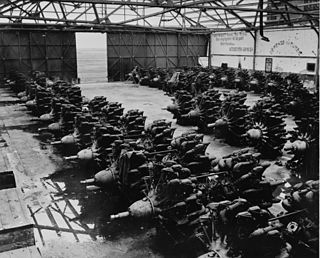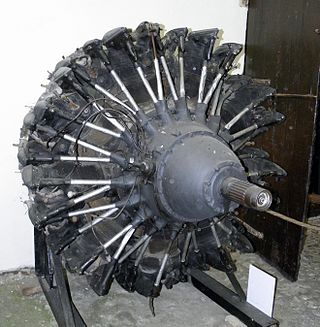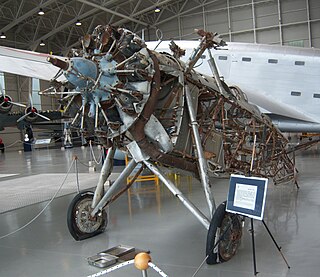Specifications

Data from Kotelnikov, Russian Aero Piston Engines
General characteristics
Components
- Supercharger: two-speed, geared
Performance
- Power output: 1,750 hp (1,300 kW)
| M-90 | |
|---|---|
| Type | Radial engine |
| National origin | Soviet Union |
| Manufacturer | Factory No.29 |
| First run | 29 November 1939 |
| Number built | 20+ |
| Developed from | Gnome-Rhône 9K |
The Tumansky M-90 was a prototype Soviet radial engine designed before World War II. It proved unreliable and incapable of reaching its designed output and was cancelled in 1944.
The M-90 began development in the spring of 1939 under the leadership of S. K. Tumansky as a coupled version of the 9-cylinder Gnome-Rhône 9K, which was built under license as the M-75. Later, possibly after E. V. Urmin assumed leadership of the project, the cylinder-piston group of the Tumansky M-88 was adopted, although the cylinder ribbing area was increased. [1]
The layout of the engine was completed by 15 August 1939 and the engineering drawing by 15 October. The first prototype began bench tests on 29 November 1939. A total of five prototypes were built in 1939 and another five in 1940. They could not reach the engine's specified power output and suffered from broken crankshafts, pinion shafts and crankcase covers. Production had been planned to begin in 1941, but this was postponed while further development work continued. More prototypes were built between 1941 and 1943 and the engine began its state acceptance tests in December 1943. It failed the tests and was cancelled in early 1944. [1]

Data from Kotelnikov, Russian Aero Piston Engines
Comparable engines
Related lists

The Shvetsov M-11 is a five-cylinder air-cooled radial aircraft engine produced in the Soviet Union between 1923 and 1952.

The Klimov VK-107 was a V-12 liquid-cooled piston aircraft engine used by Soviet aircraft during World War II.

The Mikulin AM-34 (M-34) was a Soviet mass-produced, liquid-cooled, aircraft engine of domestic design. Its initial development was troubled, but it eventually became one of the most successful Soviet aircraft engines of the 1930s. It was utilized on numerous aircraft, including the Beriev MBR-2, Tupolev TB-3, Tupolev TB-4, Tupolev ANT-20, Petlyakov Pe-8, Kalinin K-7, Polikarpov I-17, and Bolkhovitinov DB-A, as well as the G-5 and various prototype motor torpedo boats. A version of the maritime model was adapted for use in several prototype heavy tanks in 1939, although none was placed into production.

The Mikulin AM-38 was a 1940s Soviet aircraft piston engine. It was a further development of the Mikulin AM-35 design. The AM-38 was used on the Il-2 Shturmovik and Il-10 ground attack aircraft. The AM-38 was installed experimentally in a MiG-3 and tested during August 1941. A slight performance improvement was seen at low-altitude but the engine experienced overheating problems due to the cooling and oil systems remaining unchanged from the AM-35A.

The Mikulin AM-42 was a 1940s Soviet aircraft piston engine designed by Alexander Mikulin. Representing a high-output version of the AM-38F, the AM-42 was used in the Ilyushin Il-1 fighter, and the Il-8 and Il-10 ground attack aircraft.
The Tumansky M-87 was a Soviet air-cooled aircraft radial engine that was developed in the late 1930s. It was a development of their licensed Gnome-Rhone 14K engines that started with the M-85.

The Gnome-Rhône 14K Mistral Major was a 14-cylinder, two-row, air-cooled radial engine. It was Gnome-Rhône's major aircraft engine prior to World War II, and matured into a highly sought-after design that would see licensed production throughout Europe and Japan. Thousands of Mistral Major engines were produced, used on a wide variety of aircraft.

The Gnome et Rhône 18L was a French-designed twin-row 18-cylinder air-cooled radial engine. The 18L was a large step up in terms of displacement, power and number of cylinders. The majority of Gnome-Rhone engines were either 7, 9 or 14 cylinders. The engine proved not to be a success, and it was dropped in 1939 due to a poor power-to-weight ratio.
The Tumansky M-88 was an air-cooled radial engine for aircraft developed in the Soviet Union shortly before World War II.

The Shvetsov ASh-21 is a seven-cylinder single-row air-cooled radial aero engine.

Sergei Konstantinovich Tumansky was a designer of Soviet aircraft engines and the chief designer in the Tumansky Design Bureau, OKB-300. He worked in TsIAM, and at the aircraft-engine plant N 29, in Zaporozhye.

The Dobrynin VD-4K was a Soviet six-bank, 24-cylinder, turbo-compound, inline engine developed after the end of World War II. It was superseded by turboprop engines before it could be widely used.

The Charomskiy ACh-30 was a Soviet aircraft diesel engine developed during World War II. The initial version was not very satisfactory and it was cancelled when its factory was forced to evacuate in the autumn of 1941. Production was reinitiated in the summer of 1942 and continued until September 1945 to meet the need for an economical engine to power the Soviet long-range bombers like the Petlyakov Pe-8 and the Yermolayev Yer-2.
The Shvetsov M-71 was a Soviet radial engine built in small numbers during World War II. It was derived from the Shvetsov M-25, which was a license-built copy of the American Wright R-1820-F3 Cyclone engine.
The Mikulin AM-37 was a Soviet aircraft piston engine designed prior to Russia's entry into World War II. An improved version of the Mikulin AM-35 V-12 engine, it was only produced in small numbers because of its unreliability.
The Klimov M-120 was a Soviet prototype 18-cylinder liquid-cooled inline aircraft engine designed during the early years of World War II. Testing did not go well and it was cancelled in 1942.

The IAR K14 was a Romanian 14-cylinder radial aircraft engine. The IAR K14 was a licensed derivative of the French Gnome-Rhône 14K Mistral Major produced in Romania.

The Piaggio P.XII is an Italian 18-cylinder radial aircraft engine developed in the 1930s by Rinaldo Piaggio S.p.A. The P.XII was two Piaggio P.X engines in tandem, which were versions of the French Gnome-Rhône 9K Mistral made under license, themselves being much modified Gnome-Rhône 9A - a license-built Bristol Jupiter.
The Piaggio P.XIX was an Italian aircraft engine produced by Rinaldo Piaggio S.p.A. during World War II and used to power aircraft of the Regia Aeronautica.

The Piaggio P.IX, or Piaggio Stella P.IX, was an Italian nine-cylinder radial aircraft engine produced by Rinaldo Piaggio S.p.A. Based on the Gnome-Rhône 9K, the engine was rated at 600 hp (447 kW). Production was used to power a number of other aircraft developed in Italy. The main users were the Savoia-Marchetti SM.81 transport and the IMAM Ro.37bis, the main reconnaissance aircraft in the Regia Aeronautica during the Second Italo-Ethiopian War, Spanish Civil War and Second World War, but the engine was also used by other designs, including the prototype Savoia-Marchetti SM.79.